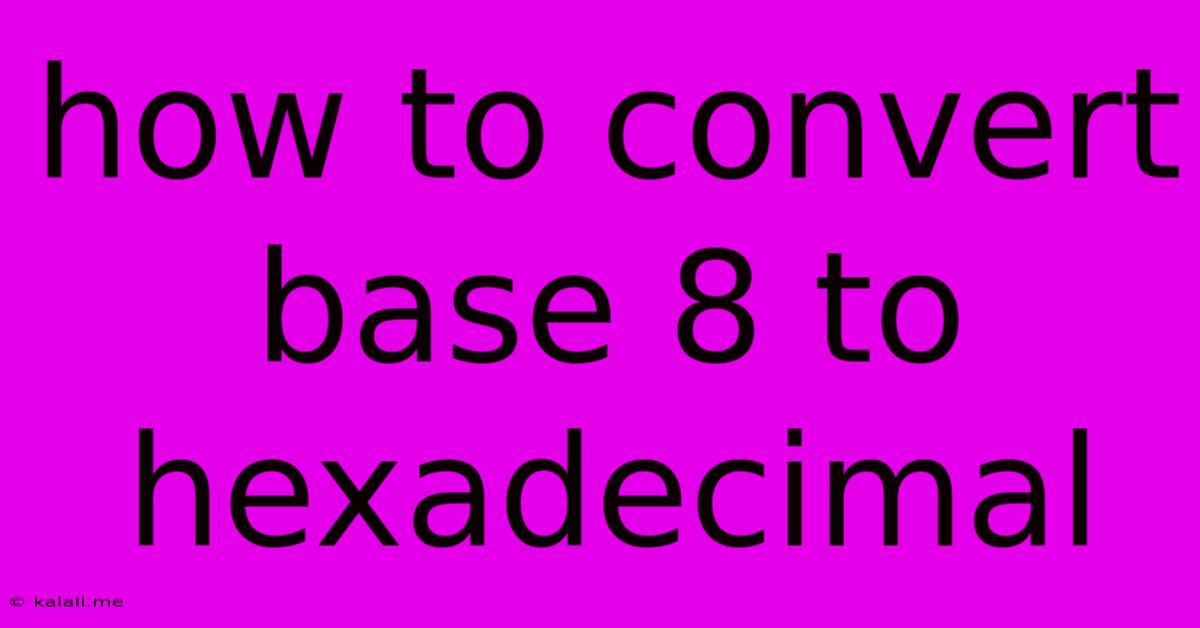How To Convert Base 8 To Hexadecimal
Kalali
Jun 12, 2025 · 3 min read

Table of Contents
How to Convert Base-8 (Octal) to Base-16 (Hexadecimal)
Converting between different number systems is a fundamental concept in computer science and programming. This article will guide you through the process of converting base-8 numbers (octal) to base-16 numbers (hexadecimal) efficiently and accurately. Understanding this conversion is crucial for working with various data formats and low-level programming tasks. We'll explore the step-by-step method, providing clear examples to solidify your understanding.
Understanding Base-8 (Octal) and Base-16 (Hexadecimal)
Before diving into the conversion process, let's briefly review the number systems involved.
-
Base-8 (Octal): Uses digits 0-7. Each position represents a power of 8. For example, the octal number 123 represents (1 * 8²) + (2 * 8¹) + (3 * 8⁰) = 64 + 16 + 3 = 83 in base-10.
-
Base-16 (Hexadecimal): Uses digits 0-9 and letters A-F, where A represents 10, B represents 11, and so on, up to F representing 15. Each position represents a power of 16. For instance, the hexadecimal number 1A represents (1 * 16¹) + (10 * 16⁰) = 16 + 10 = 26 in base-10.
The Most Efficient Method: Converting Through Base-10
The most straightforward approach to converting octal to hexadecimal involves an intermediary step: converting to base-10 (decimal) first, and then converting the decimal number to hexadecimal. This method minimizes errors and is easily understandable.
Steps:
-
Convert Octal to Decimal: Convert the given octal number to its decimal equivalent. This involves multiplying each digit by the corresponding power of 8 and summing the results.
-
Convert Decimal to Hexadecimal: Convert the decimal number obtained in step 1 to its hexadecimal representation. This is done by repeatedly dividing the decimal number by 16 and recording the remainders. The remainders, read in reverse order, form the hexadecimal equivalent.
Example:
Let's convert the octal number 732₈ to hexadecimal.
-
Octal to Decimal:
732₈ = (7 * 8²) + (3 * 8¹) + (2 * 8⁰) = (7 * 64) + (3 * 8) + (2 * 1) = 448 + 24 + 2 = 474₁₀
-
Decimal to Hexadecimal:
Divide 474 by 16 repeatedly:
- 474 ÷ 16 = 29 remainder 10 (A in hexadecimal)
- 29 ÷ 16 = 1 remainder 13 (D in hexadecimal)
- 1 ÷ 16 = 0 remainder 1
Reading the remainders in reverse order, we get 1DA₁₆.
Therefore, 732₈ = 1DA₁₆
Alternative Method: Bit Manipulation (For Advanced Users)
A more advanced technique utilizes bit manipulation, leveraging the fact that 8 is 2³, and 16 is 2⁴. This method is faster for larger numbers but requires a stronger understanding of binary representation. This approach involves converting octal to binary, grouping the bits into groups of four, and then converting those groups into hexadecimal digits. While efficient, it's more complex for beginners.
Conclusion
Converting base-8 to base-16 is a valuable skill for programmers and anyone working with different number systems. The method of converting to decimal as an intermediary step offers a clear, simple, and reliable approach. While the bit manipulation method exists, it is generally recommended to use the decimal conversion method unless you are experienced with binary and bitwise operations. Mastering these conversions will enhance your problem-solving abilities in various computing contexts.
Latest Posts
Latest Posts
-
Memorandum Of Agreement Vs Memorandum Of Understanding
Jun 13, 2025
-
Least Common Multiple Of 27 And 45
Jun 13, 2025
-
What Is The Factor Of 71
Jun 13, 2025
-
10 Is 30 Of What Number
Jun 13, 2025
-
Florida A And M Acceptance Rate
Jun 13, 2025
Related Post
Thank you for visiting our website which covers about How To Convert Base 8 To Hexadecimal . We hope the information provided has been useful to you. Feel free to contact us if you have any questions or need further assistance. See you next time and don't miss to bookmark.